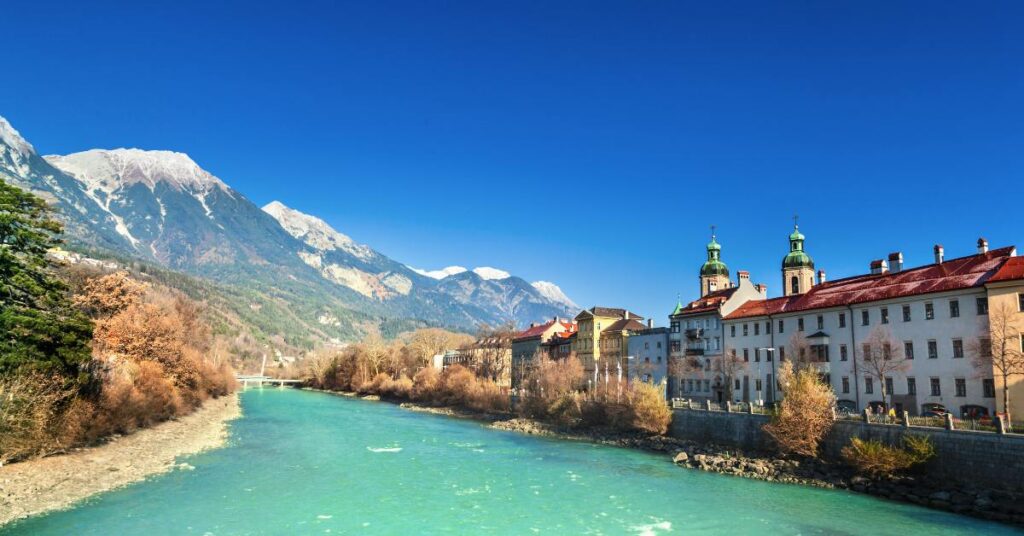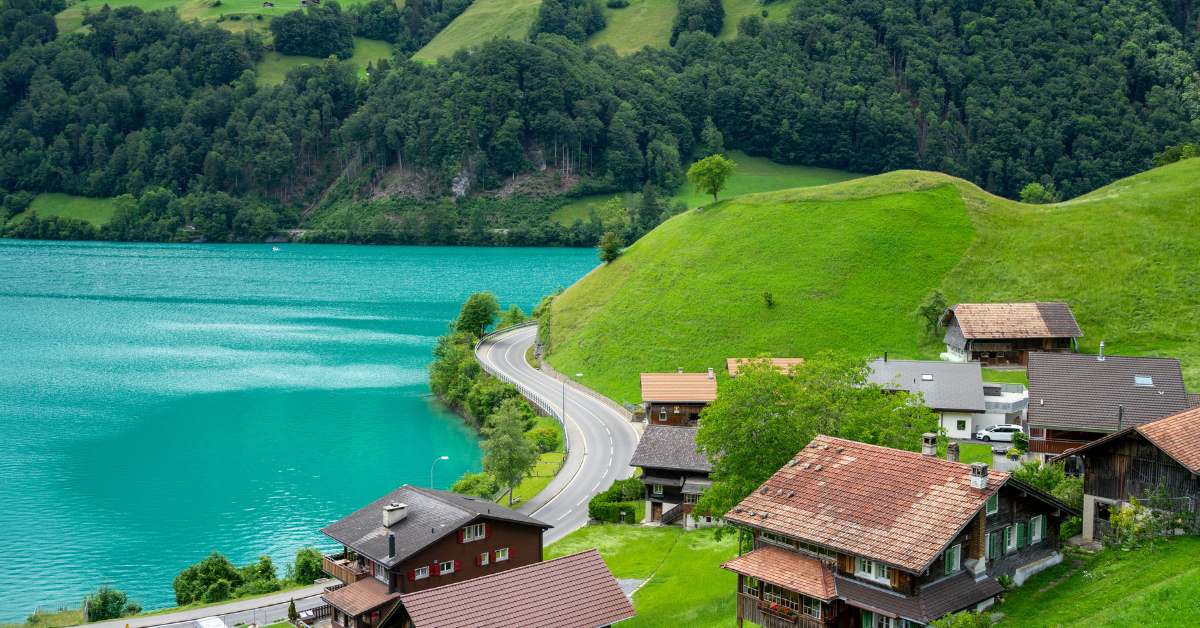Welcome to Trip Trek Tales, Innsbruck a beautiful town of Austria. In this article, we have provided a complete guide to Innsbruck. Read till the end and plan your vacation to Innsbruck.
Innsbruck is located in the Tyrol region of Austria and it is a marvelous city full of culture, history and beautiful mountains. Since it is a place associated with winter sports and summer fun as well, it offers a large range of activities and sights for every tourist and every option in between. It has a medieval Old town to its Nordkette’s offerings that can boast off of amazing views that allow it to be a perfect vacation for history lovers, the adventurous ones and the art lovers. Here’s an extensive guide to the 12 best places to visit in Innsbruck that will help you make the most of your trip.
1. Wander Old Town Innsbruck

Old Town Innsbruck (Altstadt) is the center of the city representing well preserved medieval quarter to take tourists back in time. Street called Graben (Moat) surrounds this semi-circular section of the Old Town forming a pedestrian zone offering the pleasure of history and beauty of the architecture.
Key Highlights:
- Golden Roof (Goldenes Dachl): This architectural monument should be ranked first on the list of attractions in Innsbruck. The golden roof was built in 1496, and there are 2657 copper tiles completed with gilding. Originally it was built to celebrate the events marking the wedding of Maximilian I to Bianca Maria Sforza. Many massive historical events in Innsbruck revolve around this dome, especially when the roof is above the square where earlier civil reenactments used to take place.
- Stadtturm (City Tower): The Tower stands at 57 m and is equipped with a medieval watchtower from the bounded area from which the Old Town and the mountains can be sighted. Ascending the narrow spiral staircase comes provides an impressive view of Innsbruck’s historic layout.
- Helblinghaus: This Baroque structure is also noted for its rich stucco decoration with angels included in its complex. The Helblinghaus is indeed very attractive and is a fine representation of the arts that can be seen in the town of Innsbruck.
- Ottoburg and Deutschordenshaus: Both these historical buildings contribute to the understanding of how Innsbruck used to be. The Ottoburg Tower built in 1494 and the Deutschordenshaus built in 1532 tell the history of the city.
Walking along these streets is like taking a step back in time in medieval Innsbruck, with many quaint restaurants and shops to explore during the journey.
2. Experience the “Top of Innsbruck” from the Nordkette

As for panoramic alpine views and a whole bunch of outdoor activities, Nordkette is simply a must for tourists. This mountain range is the most proximate to Innsbruck and it creates an interesting alternative to the medieval architecture of the city.
Getting There:
- Hungerburgbahn Funicular: This is a contemporary funicular stratum designed and touristed by Zaha Hadid, built right in the Center of Innsbruck and leading up to the Hungerburg area. This journey takes you across River Inn and throughout the entire journey, beautiful views of the city can be witnessed.
- Nordkette Cable Car: Beyond Hungerburg, the Nordkette Cable Car takes you up further to Seegrube and then to the top of Hafelekar Peak at 2300m above sea level. The vistas from this point are absolutely marvellous offering the view of high mountains all around and Innsbruck down the hills from all sides.
Activities:
- Hiking: There are several trails from the top that cater to varying levels of experience. Enjoy the fresh alpine air and explore the rugged terrain.
- Dining: The different stations of the cable cars and cog trains ringed by forests have restaurants serving delicious local and alpine food with splendid sights.
- Innsbruck Card: We advise you to consider the purchase of this pass for the possibility to ride not only the funicular and the cable car but also many of the attractions across the city.
3. Visit the Court Church & Emperor’s Tomb
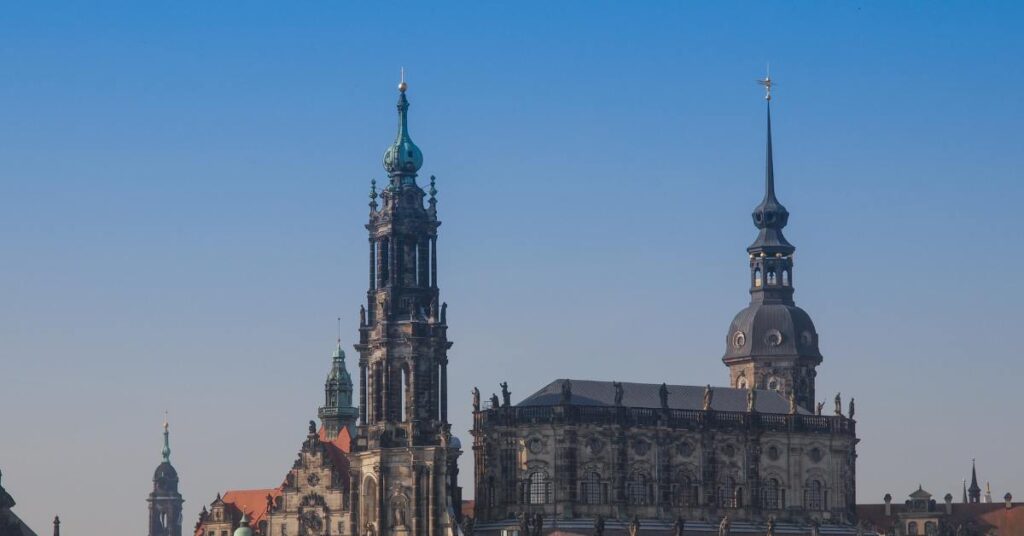
The Court Church (Hofkirche) is a remarkable example of Late Gothic architecture, completed in 1563. It is renowned for its impressive interior and the notable Tomb of Emperor Maximilian I.
Key Highlights:
- Emperor Maximilian I’s Tomb: This grand monument, built in the 16th century, is a masterpiece of German Renaissance sculpture. The black marble sarcophagus is adorned with a bronze figure of the Emperor and surrounded by 24 marble reliefs depicting significant events from his life.
- Bronze Statues: The church features 28 bronze statues of Maximilian’s ancestors and contemporaries, including a notable statue of King Arthur.
- Interior Features: The Hofkirche’s high altar, side altars, and choir screen are noteworthy for their artistic details and historical significance.
Visiting the Hofkirche provides a deep dive into Austrian history and the artistry of Renaissance sculptors.
4. See the Famous Golden Roof
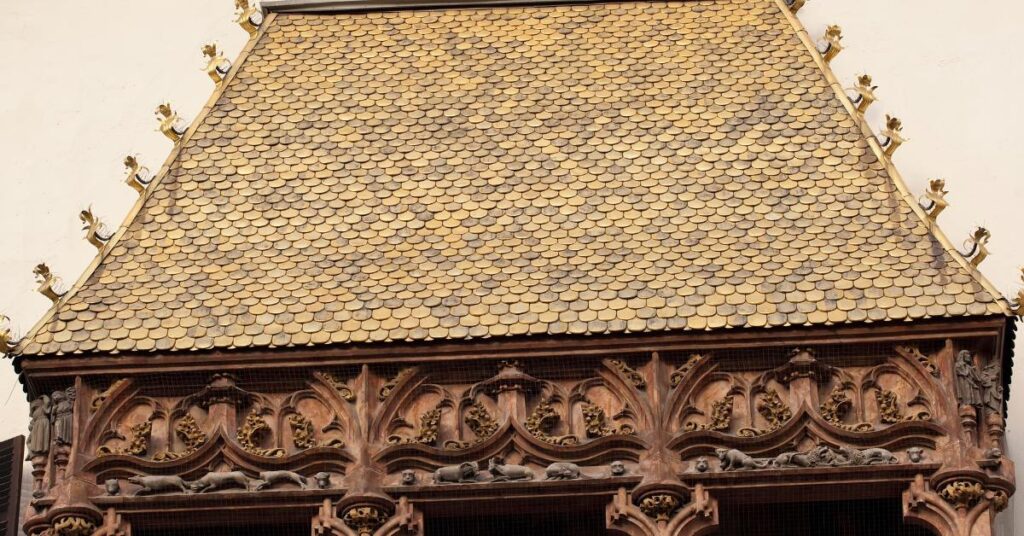
As for the Golden Roof, its golden glided roof is possibly one of the sights one would first notice when in the city of Innsbruck. It has given sense to the region through its history and has been described in picture maps.
Features:
- Architecture: The roof is enriched with 2,657 gilt copper tiles, which casts a shimmer when under the sun. The ornately detailed lower balustrade and the sculptured figures above are typical features of Last Gothic designs.
- Historical Significance: The Golden Roof was constructed as a gesture of festivity to accompany the wedding of Emperor Maximilian I, while its Imperial Court observed activities ranged in the ordinary public square below.
The location is scenic and great for taking pictures because it preserves the art and history of Innsbruck.
5. Take a Tour of The Hofburg, Innsbruck’s Old Imperial Palace
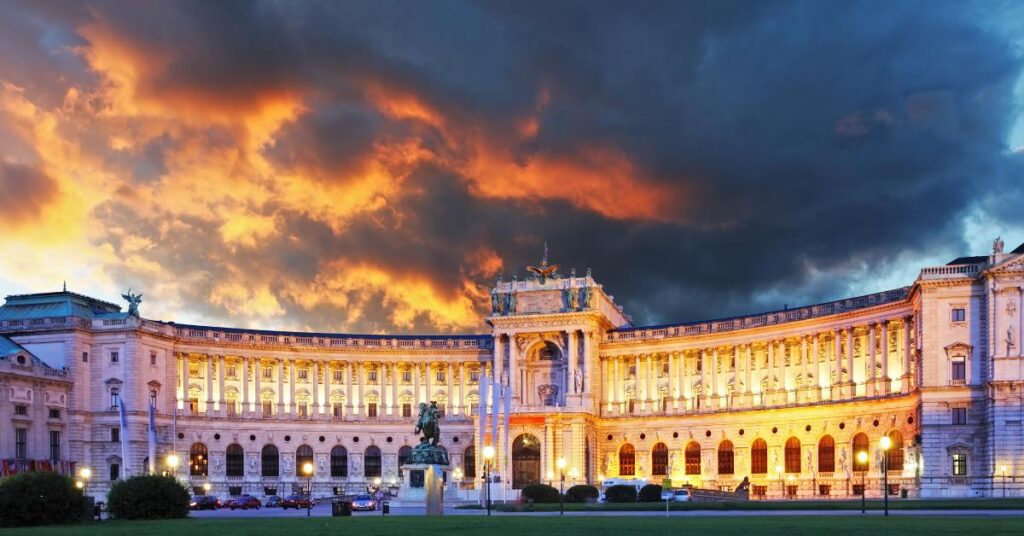
The Hofburg was once an imperial palace and is now a museum showcasing the opulence of the former Habsburg court.
Key Features:
- Baroque and Rococo Interiors: The Hofburg is renovationed during the 18th century at the command of Empress Maria Theresa. The Giant Hall (Riesensaal) is especially striking due to marble decoration and ceiling frescoes of huge dimensions.
- Historical Rooms: Discover the spaces occupied by the Austrian royals when they were still in extreme power and magnificence, including Princess Maria Theresa’s rooms, the couch of Empress Elisabeth, and the Ancestors’ Picture Gallery.
- Museum Exhibits: Also the museum presents Painting Gallery and Furniture Museum which enrich the special complex of culture and art of the Hapsburg dynasty.
The Hofburg is a testament to the grandeur of the Austrian Empire and offers a comprehensive look at its history.
6. Catch a Concert at Innsbruck Cathedral
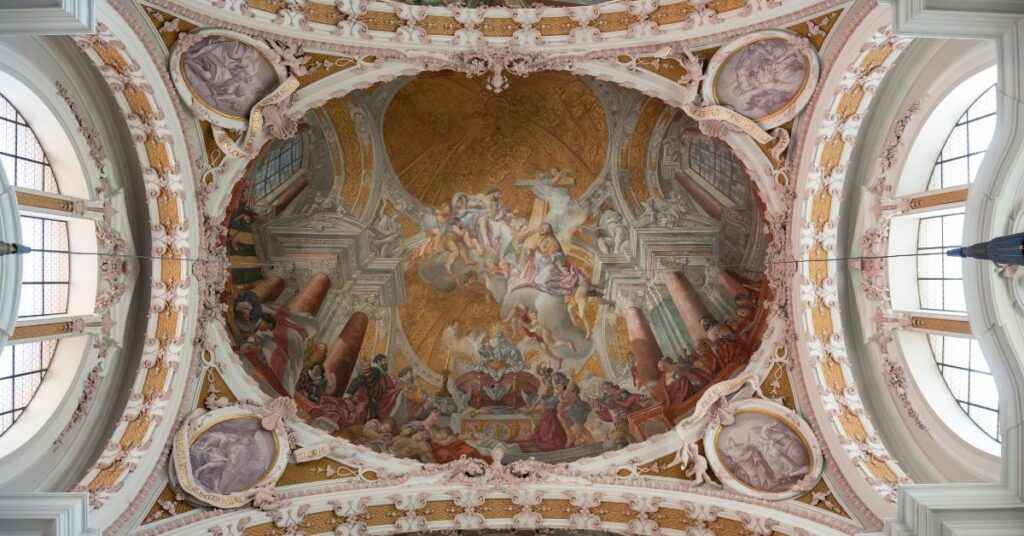
Innsbruck Cathedral, also known as the Cathedral of St. James, is a beautiful Baroque building located in Domplatz.
Features:
- Architecture: The cathedral is famous for its twin towers and a high dome. Completed in 1724, the cathedral features a remarkable stucco decoration by the Asam brothers and majestic ceiling paintings.
- Monument: The memorial to Archduke Maximilian in the aisle on the left side of the church is a domineering structural element, crafted by Hubert Gerhard.
- Concerts: Most of the time the cathedral has a concert which is quite famous as this is one of the old buildings and has sessions of classical music.
The cathedral’s serene atmosphere and artistic details make it a worthwhile visit for both its historical and cultural offerings.
7. Get Your Art Fix at the Tyrolean State Museums
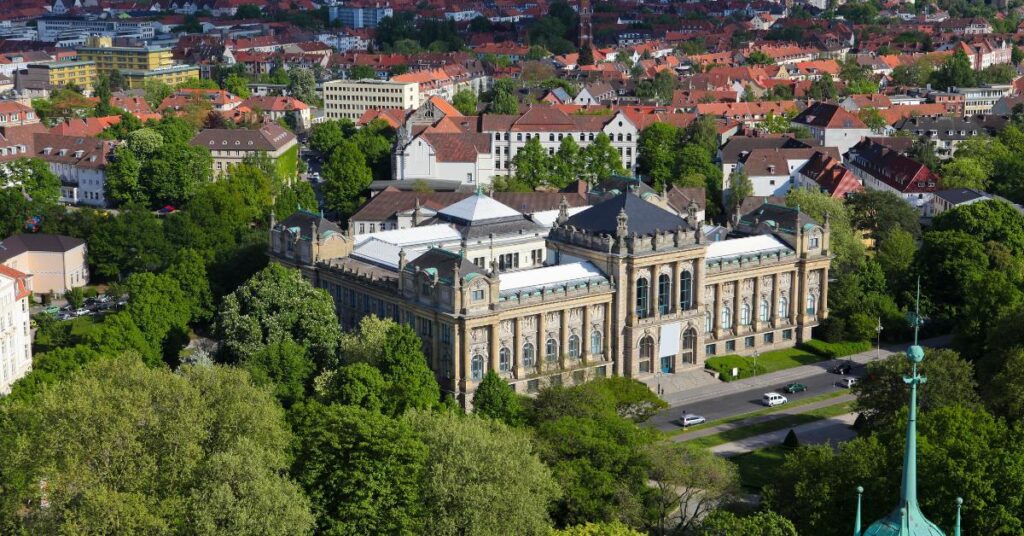
Innsbruck’s Tyrolean State Museums offer a rich array of art and history, perfect for those interested in local culture.
Notable Museums:
- Tyrolean Folk Art Museum (Tyroler Volkskunstmuseum): This museum, located near the Hofkirche, is full of artefacts and photographs from the region of Tyrol that show traditional Tyrolean art, costumes cladding, ubiquitous metal work and furniture.
- Tyrolean State Museum (Tyroler Landesmuseum Ferdinandeum): This museum showcases collections from various periods, including Gothic art, Dutch and Flemish masters, and pre-historic artifacts.
- Museum im Zeughaus: This museum has some fascinating historical military weapons and arms, which can also be described as arms employable in warfare.
- Tyrol Panorama Museum: A large section of the artwork belongs to the enormous wall painting of hypnotherapy and its surroundings providing an exquisite image of city.
These museums will also enable visitors to appreciate Tyrolean art and history, thus augmenting your knowledge about the cultural existence of the region.
8. Stroll along Maria-Theresien Strasse
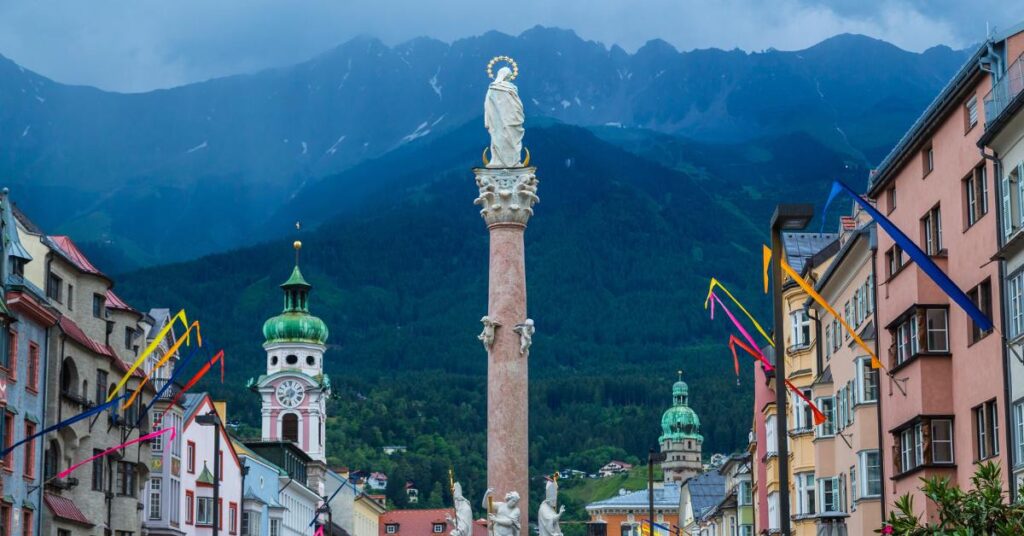
It is one of the busiest roads in Innsbruck is well developed and historic and has a panoramic view of the mountains surrounding the town.
Key Highlights:
- St Anne’s Column (Annasäule): This column, instituted in 1706, commemorates the retreat of the Bavarian army and features the Virgin Mary figure.
- Triumphal Arch (Triumphpforte): It is located at the southernmost end of Maria-Theresien Strasse and is a curved arch built for noble Emperor Leopold II at the marriage festival in the year 1765.
- Altes Landhaus: It is a monumental building of Baroque palace style which is currently occupied by the Province Assembly and the Government. Its father’s embellishment is very historic and architectural in nature.
- Alpine Club Museum: This is one of the museums established along this street. This museum usually contains Alpine art as well as climbing artifacts of olden days.
Maria-Theresien Strasse is a lively area perfect for a leisurely stroll, with plenty of shopping and dining options.
9. Explore the Hofburg District
The Hofburg District is a mix of modern buildings with old ones, cultural institutions and some interesting attractions to see.
Key Sites:
- Silver Chapel: Constructed in 1587 as a funerary chapel, the chapel is famous for its silver altar and scenes of swords.
- Old University: Founded in 1562 this college is of historical significance for the order of Jesuits.
- The Jesuitenkirche (the Jesuit Church): It is best known for its impressive dome that rises to the height of 60 tier and others baroque structures.
- Tyrolean Provincial Theater: The repertoire of the theater includes opera, drama and musicals, and allows everybody to enjoy action on stage.
- Hofgarten: A lovely park which is a green refuge right in the center of the city and a place where it is possible to take a walk in the warmth.
The Hofburg District encapsulates Innsbruck’s cultural and historical richness, making it a must-visit area.
10. Grassmayr Bell Foundry & Museum
The Grassmayr Bell Foundry is one of the oldest bell foundries in the world and offers a unique glimpse into the craft of bell-making.
Features:
- Historic Craftsmanship: The foundry has been in operation since 1599, producing bells for churches, municipalities, and private clients.
- Museum: The museum displays a range of historical bells, bell-making tools, and provides insights into the art of casting and tuning bells.
- Live Demonstrations: Visitors can witness live bell castings and learn about the intricate process involved.
- Shop: The foundry’s shop offers a selection of bells and related products, perfect for souvenirs.
Visiting the Grassmayr Bell Foundry offers a fascinating look into a traditional craft that continues to thrive in Innsbruck.
11. Walking Tour along the River Inn
A delightful stroll along the River Inn gives you a scenic view of Innsbruck with a new perspective.
Key Areas:
- Mariahilf District: This area, with its ancient church and a botanical garden, provides a peaceful respite from the hectic city life.
- Hötting Ridge way: This elevated walkway provides stunning views of Innsbruck and the surrounding landscapes.
- St. Nikolaus District: The community with many old buildings and many attractions with fresh markets.
- Old Inn Bridge(Alte Innbrücke): The ancient bridge with a market which is very active at this time, especially on Christmas.
Walking along the River Inn provides a refreshing and picturesque view of Innsbruck, with plenty of opportunities to explore the city’s diverse neighborhoods.
12. Visit the Opulent Ambras Castle
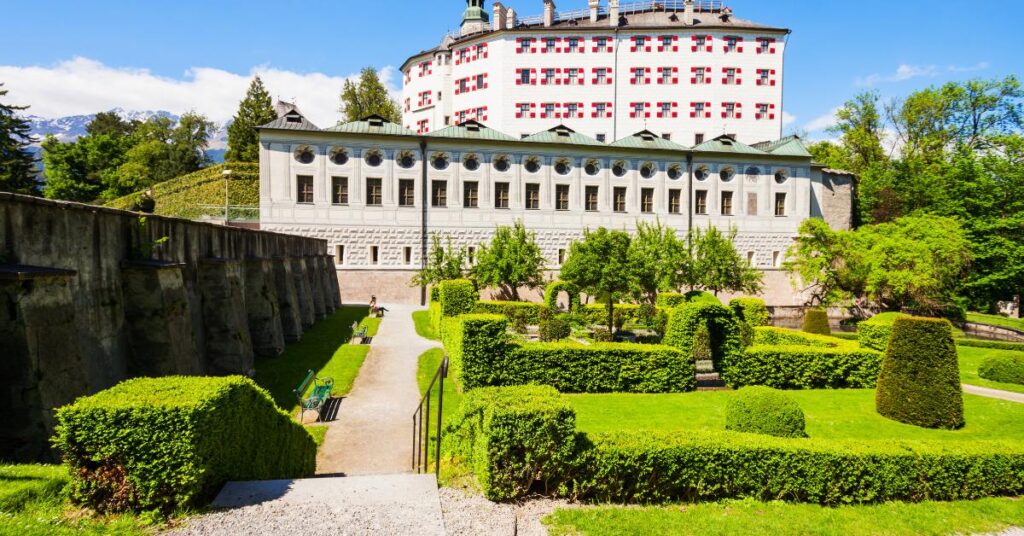
Innsbruck is distinguished by Ambras Castle (Schloss Ambras) a renaissance structure most regarded for its beautiful artworks and the vast collections found in the castle
Key Highlights:
- Spanish Hall: One of the most significant Renaissance halls in Europe, featuring a coffered ceiling and intricate frescoes.
- Collections: The castle houses extensive collections of arms, armor, and artworks, including portraits of the Habsburg family.
- Private Rooms: Explore the private bathroom of Archduchess Philippine and other historical rooms.
- Castle Grounds: The castle is set in beautiful grounds, offering a pleasant area for a stroll.
Ambras Castle is a remarkable example of Renaissance architecture and offers a deep dive into the Habsburg era’s opulence.
Conclusion
With its interesting history, culture and nature, Innsbruck also has a wide variety of sights and leisure possibilities. From the medieval old town to the mesmerizing view from Nordkette, each site presents a different aspect of the city’s history and day to day activities. Whether it is the majestic Hofburg palace, a view from the Golden Roof, or a concert at Innsbruck Cathedral, the city has something to offer all its visitors. When it comes to the fusion of tradition and contemporary culture, they all find that Innsbruck is the place to be.
Hello I am Jyoti, I have been a constant travel writer for Trip Trek Tales. I love travelling and therefore, I wanted to contribute in this field. Travelling, writing and reading are the things that I love the most and this is the main reason why I started my career in writing.
At Trip Trek Tales, I am sharing the best information related to the field of travelling. All the information in the articles are after thorough research, personal experiences and knowledge. Hope you love my writings. Thank you. Have a happy travel!

